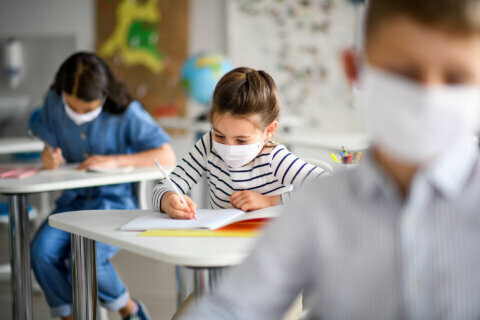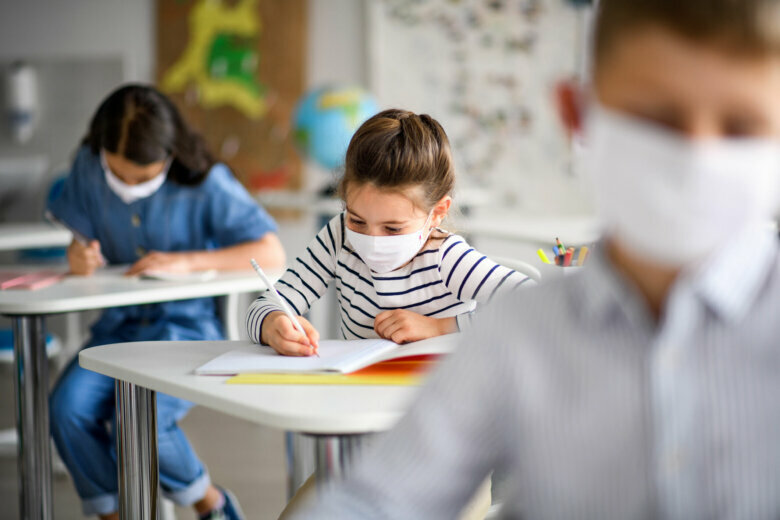
The timing isn’t great.
As school kids head back to classrooms for in-person learning five days a week, the nation — including the D.C. region — is seeing an increase in the number of positive COVID-19 cases attributed to the more infectious delta variant.
WTOP asked pediatrician John Farrell, of South Riding Pediatrics, about the risks. Farrell chairs the Loudoun County Health Commission, which advises the Loudoun County Board of Supervisors on health issues and policy.
- Q: Really? I thought this school year was supposed to be 'normal'
“In a typical year, we’re doing back-to-school sports physicals at the last second, and getting kids caught up with the immunizations that they need. This summer, we’re seeing a lot of out-of-season respiratory illnesses that we normally see in January and February,” Farrell tells WTOP.
Farrell said it’s not clear why croup, strep throat and other contagious viruses are appearing at this time of year. While some hypothesize it’s because children — who frequently spread disease in a community — are interacting frequently, Farrell said it is still too early to pinpoint the cause.
“We went for two months with no positive COVIDs,” said Farrell. “We’re testing approximately 20 to 30 kids a day with respiratory symptoms. In the last three weeks we’ve started to see an uptick.”
“I think I saw seven (positives) last Wednesday. So that’s quite a percentage increase, when you go from zero to seven in one day.”
- Q: How risky is the delta variant for kids at school?
“We’ve certainly seen transmission from vaccinated adults, potentially giving it to unvaccinated children,” said Farrell. “That’s certainly worrisome, and dictates changes in public health policy.”
The near-doubling of COVID-19 cases among young people is troubling, but Farrell said “in general, thankfully, children and adolescents are doing quite well with this” in avoiding serious illness.
“The number’s not zero, and there’s always some risk, but I’m not seeing an increased virulence or severity of disease, with the small number of cases we’ve seen in our office,” Farrell said. “Certainly, only a very small number of kids are reaching the hospital.”
- Q: Isn't the vaccine supposed to help prevent COVID-19?
It is preventing a lot of it, said Farrell.
“We relaxed our masking, we relaxed our social distancing, all in hopes that we’d had this behind us, and we’re now seeing a pandemic in the unvaccinated,” said Farrell. “But unfortunately that includes children under 12.”
Nationally, Dr. Lee Savio Beers, the president of the American Academy of Pediatrics, said about 27% of 12-to-15-year-olds are fully vaccinated, and about 39% of those 16 and 17 are fully immunized.
“I’m really not seeing too much vaccine hesitancy,” said Farrell. “Of course there’s always some — I think a lot of that’s due to just poor communication of information out there.”
- Q: Is it a good idea for schools to move forward with in-person learning, with all the unknowns about the delta variant?
Yes, said Farrell. The benefits of returning to in-person learning far exceed the risk of a child getting seriously ill from COVID-19.
“You’re certainly going to see younger people getting this disease, because, in general, younger people aren’t vaccinated. A good portion of them can’t get it, and then a number just haven’t received it,” said Farrell.
That said, according to Farrell, last year’s virtual learning environment is not the answer, because it is detrimental to a child’s mental health.
“As a card-carrying member of the Virginia American Academy of Pediatrics Back to School Task Force, we’ve devoted many, many hours trying to get kids back in schools, five days a week — I think we have to start from that premise,” said Farrell.
Farrell said the decision by resume in-person learning, with indoor masking for all students and teachers is appropriate.
“Let’s all agree that the enemy here is the coronavirus — it’s not school boards, and it’s not public health officials,” Farrell said. “So, if your enemy is the coronavirus and your goal is to get kids back in school, five days a week, I would say I am very comfortable with the masking decisions that have been made by our local school boards.”









